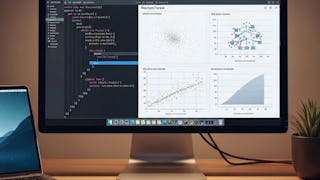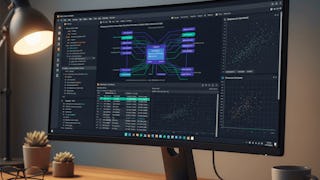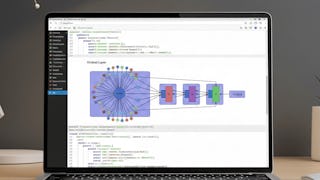By completing this course, learners will be able to prepare datasets in R, apply statistical and visualization techniques, build regression models, and design, run, and evaluate neural networks. The course begins with data preparation essentials, including working with dataframes, descriptive statistics, and environment setup, ensuring learners can confidently manage their workflow. It then advances to data visualization, where learners generate line graphs, scatter plots, and advanced visualizations to interpret patterns and relationships. Regression modeling concepts are introduced to provide a solid predictive foundation. Finally, the course transitions to deep learning, guiding learners through dataset preparation, neural network coding, multilayer perceptron (MLP) architecture, and predictive testing.


What you'll learn
Prepare datasets, apply stats, and create visualizations in R.
Build and evaluate regression models for predictive analysis.
Design, run, and test neural networks using R and MLPs.
Skills you'll gain
- Performance Testing
- Data Science
- Scatter Plots
- Descriptive Statistics
- Model Evaluation
- Data Manipulation
- Artificial Neural Networks
- Regression Analysis
- Predictive Analytics
- Data Visualization Software
- R Programming
- Predictive Modeling
- Deep Learning
- Statistical Methods
- Data Preprocessing
- Plot (Graphics)
- Statistical Modeling
Details to know

Add to your LinkedIn profile
October 2025
13 assignments
See how employees at top companies are mastering in-demand skills

There are 3 modules in this course
This module introduces learners to the fundamentals of working with R for data science and deep learning projects. Learners will explore dataframes, descriptive statistics, directory setup, variable assignment, and essential R syntax. The module ensures that learners can confidently prepare their environment and datasets before advancing to complex modeling.
What's included
11 videos4 assignments
This module focuses on building strong visualization and regression skills in R. Learners will generate various plots such as line graphs, scatter plots, and multiple plot frames to explore data patterns. The module also introduces regression modeling concepts, including linear and multiple regression, to establish a strong foundation for predictive modeling.
What's included
9 videos4 assignments
This module transitions learners from regression models to deep learning with neural networks in R. It covers preparing datasets, running neural network code, analyzing hidden layers, and evaluating model predictions. By the end of the module, learners will be able to design, execute, and test neural networks for real-world predictive tasks.
What's included
17 videos5 assignments
Explore more from Machine Learning
 Status: Free Trial
Status: Free Trial Status: Free Trial
Status: Free Trial Status: Preview
Status: Preview Status: Free Trial
Status: Free Trial
Why people choose Coursera for their career





Open new doors with Coursera Plus
Unlimited access to 10,000+ world-class courses, hands-on projects, and job-ready certificate programs - all included in your subscription
Advance your career with an online degree
Earn a degree from world-class universities - 100% online
Join over 3,400 global companies that choose Coursera for Business
Upskill your employees to excel in the digital economy
Frequently asked questions
To access the course materials, assignments and to earn a Certificate, you will need to purchase the Certificate experience when you enroll in a course. You can try a Free Trial instead, or apply for Financial Aid. The course may offer 'Full Course, No Certificate' instead. This option lets you see all course materials, submit required assessments, and get a final grade. This also means that you will not be able to purchase a Certificate experience.
When you purchase a Certificate you get access to all course materials, including graded assignments. Upon completing the course, your electronic Certificate will be added to your Accomplishments page - from there, you can print your Certificate or add it to your LinkedIn profile.
Yes. In select learning programs, you can apply for financial aid or a scholarship if you can’t afford the enrollment fee. If fin aid or scholarship is available for your learning program selection, you’ll find a link to apply on the description page.
More questions
Financial aid available,


